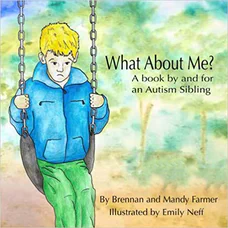What About Me?
A book by and for an Autism Sibling
Written by Mandy Farmer and Brennan Farmer
Illustrated by Emily Neff
32 pages
•
Published 2017 (Farmer Publishing)

Recommended Age Range: 1st grade through 4th grade.
Publisher's Summary:
Having a sibling on the spectrum brings great joy. It also brings a flurry of emotions, challenges and questions. Written by a seven-year-old boy, “What About Me?” works through the day-to-day struggles and joys of being an autism sibling.

Dr. Annie's Takeaways
Recommended for: This book is ideal to read with children who have autistic siblings and who can sit through a longer, wordier book. It celebrates positive aspects of the siblings’ relationship and builds empathy and understanding for a sibling’s experience while validating some of the very real challenges that can come with having an autistic brother or sister. For children who have ever asked, “What about me?” when their sibling goes to therapy and gets to play games, or when family decisions are made based on an autistic sibling’s needs, this book validates these experiences and provides some useful coping strategies.
Would a child like it? The book is a bit long, and it has a lot of words and no plot to speak of. But many children with autistic siblings will find it validating and will feel relieved that the adults in their life understand and care about their experience too.
Evidence-Based Practices:
Psychoeducation
Tone: Informative, normalizing
Story Quality: This story was written by 7-year-old Brennan Farmer and his mother Mandy and is based on Brennan’s experience having an autistic brother. The story has a lot of authenticity, and it’s likely to feel validating to many kids with autistic siblings. It isn’t a particularly engaging story; it’s fairly didactic, has a lot of words, and doesn’t have a plot (e.g., “Because my brother has autism, some outings are very hard for him. He hears, sees, and smells better than most people, but this can make public places very loud and bright for him. When there is a lot of noise, he covers his ears and cries because it hurts.”) However, if a child is able to sit through it, the content is much-needed.
Illustrations: The illustrations are quite amateur-looking, and they veer between childlike and a bit unsettling. They aren’t the book’s best asset.
Representation: Brennan is a non-autistic boy with an autistic brother (Brennan states that his brother “has autism”), non-autistic sister, and mother. The family is White. Brennan’s brother has in-home therapists and participates in OT where he gets sensory input through activities like swinging. He likes dinosaurs and has challenges with emotion regulation, sensory overwhelm, and play skills like sharing.
Psychological Practices: This book normalizes and validates experiences common to children with autistic siblings. Brennan describes positive aspects of his relationship with his brother, including playing outside together and learning about dinosaurs from him. He also shares about more challenging aspects, which many children with autistic siblings will relate to. He describes feeling left out and jealous when his brother gets attention from doctors and therapists and he doesn’t; feeling angry and sad when his family has to leave a fun outing because of his brother’s needs; having a hard time understanding that his brother has different rules from him; and feeling hurt when his brother struggles with emotion regulation and screams and throws things. In a poignant moment, Brennan shares how it makes him sad that his mother often needs to attend to his brother’s emotional needs first, and he shares that sometimes his mother cries too, which shows him that “it’s okay to cry when it’s hard.” Importantly, Brennan provides the reader with strategies that have helped him to cope with these challenges. He brings games and books to his brother’s appointments, has a space at home with a lock on the door so that he can have privacy when he needs it, and by learning about his brother’s needs, he has developed empathy and understanding that help him to cope (e.g., after his family has to go home early from a fair due to his brother’s distress, he reminds himself that his brother finds loud noises and bright lights painful and he doesn’t want him to be in pain). The book does a really nice job validating feelings without being too negative, and it provides solutions without glossing over painful feelings. It would be an excellent book for parents and caregivers to read with a child who is struggling with the attention and accommodations their autistic sibling is receiving.
Concerns: None.
